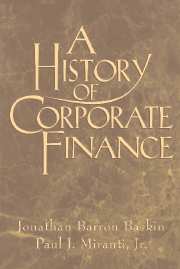Book contents
- Frontmatter
- Contents
- Preface
- Introduction: History and the Modern Theory of Finance
- Part I The Preindustrial World
- Part II The Rise of Modern Industry
- Part III The Transition to the Contemporary Era
- Epilogue
- APPENDIX A Finance and Informational Asymmetries in the Ancient World
- APPENDIX B International Patterns of Corporate Governance
- Index
Introduction: History and the Modern Theory of Finance
Published online by Cambridge University Press: 22 March 2010
- Frontmatter
- Contents
- Preface
- Introduction: History and the Modern Theory of Finance
- Part I The Preindustrial World
- Part II The Rise of Modern Industry
- Part III The Transition to the Contemporary Era
- Epilogue
- APPENDIX A Finance and Informational Asymmetries in the Ancient World
- APPENDIX B International Patterns of Corporate Governance
- Index
Summary
The Two Lenses of Economic Theory
History and statistics have long been thought of as vital adjuncts in scholarly efforts to further the understanding of economics and allied fields such as corporate finance. In his classic work, The Scope and Method of Political Economy (1890), John Neville Keynes, for example, characterized the nature of the relationship between these two specializations as essentially complementary. Inherent in this view was the belief that economic understanding could be brought into sharpest focus only by blending the unique perspectives afforded by each discipline, like the images cast by the separate lenses of a stereoscope.
Although in general accord with Keynes about the relevance of these two types of knowledge, Joseph A. Schumpeter later expressed, in his History of Economic Analysis (1954), the controversial opinion that historical studies were the more important. In his view economics was a uniquely historical process whose significance could be fully grasped only when viewed in a broader social context which incorporated events, institutions, individuals and organizations. In contrasting history with statistics and theory as a focus of scholarly endeavor, he wrote:
Of these fundamental fields, economic history – which issues into and includes present day facts – is by far the most important. I wish to state right now that if, starting my work in economics afresh, I were told that I could study only one of the three but could have my choice, it would be economic history that I would choose. And this is on three grounds.
- Type
- Chapter
- Information
- A History of Corporate Finance , pp. 1 - 26Publisher: Cambridge University PressPrint publication year: 1997



